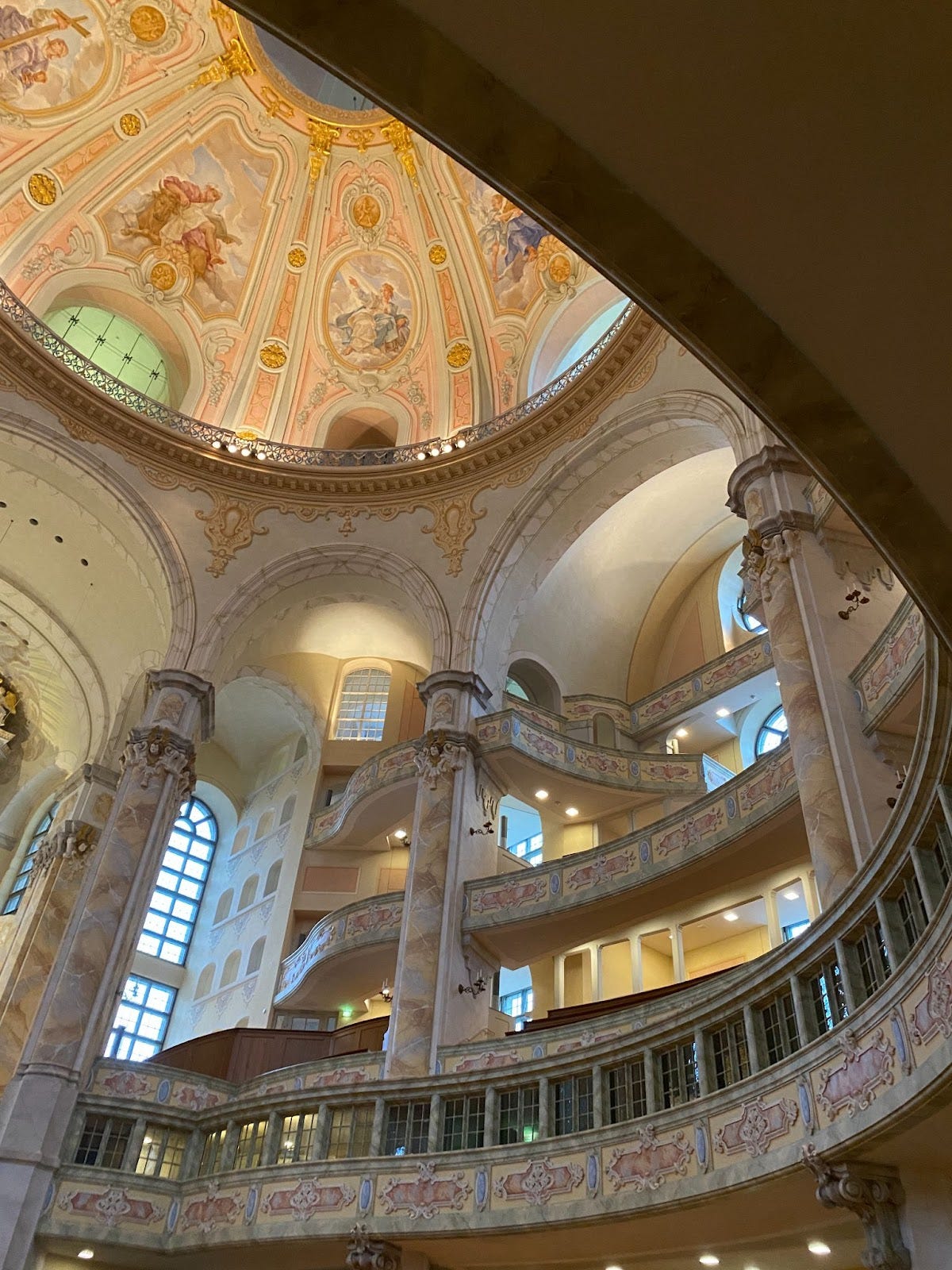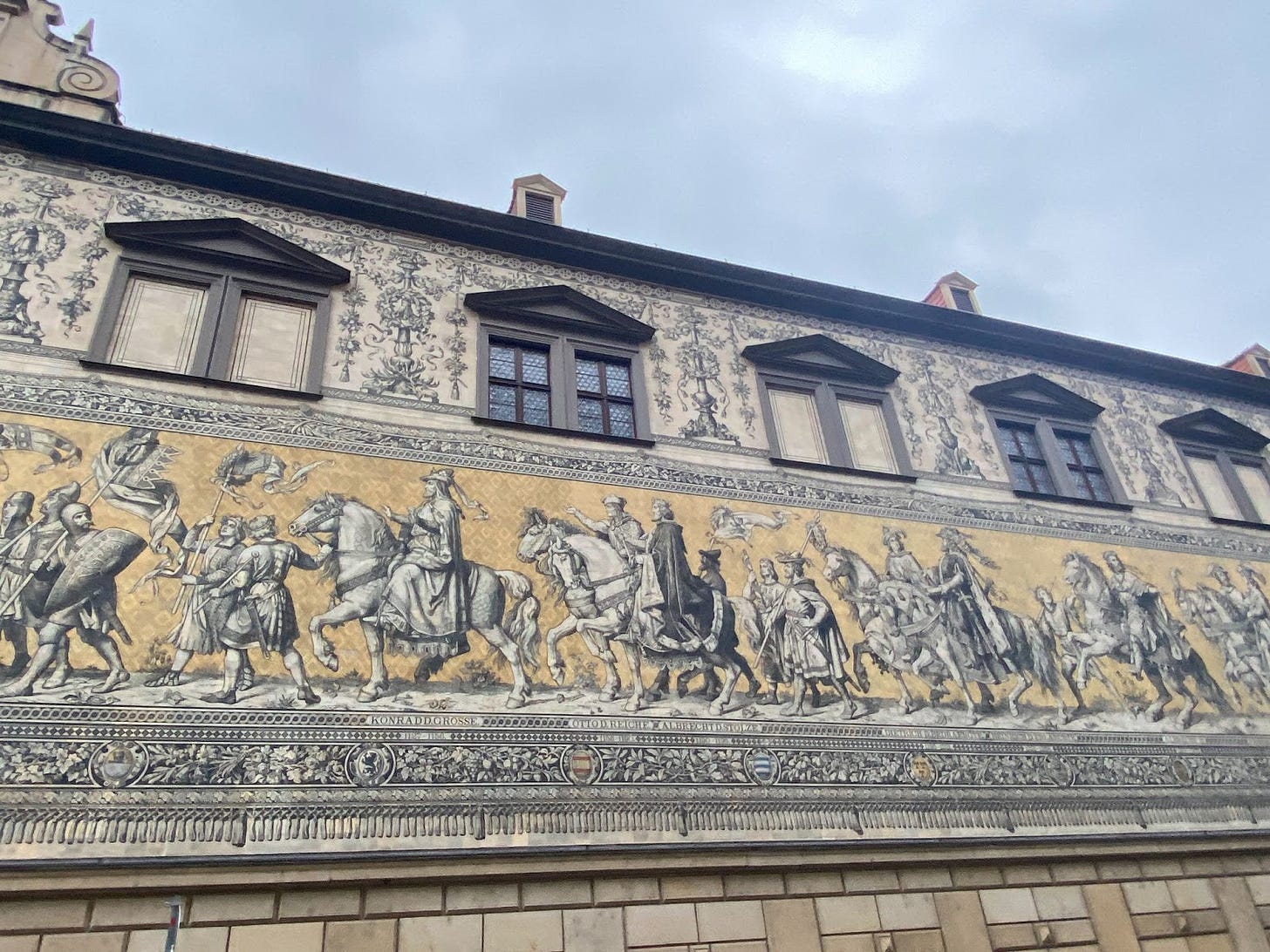Welcome
Today we hop back on the autobahn and drive south from Berlin to Dresden.
We were enroute to our next major stop (which I will feature next week), so we were only in Dresden a few hours over lunch time but there is still a lot to share.
Many of you have been reading my issues since the beginning. Today we are at Issue 35, so there have been many free articles to read and places to dream about from where I have taken you.
At the end of February we will have completed this current theme of a European Vacation.
From March, I will be introducing a small fee to read each issue in its entirety.
There will always be sections that are free, but to read everything from each issue, you will need to upgrade to a paid subscription from Issue 39 onwards.
I truly appreciate each and every one of you who read my newsletter each week over the past 7 months, but the time has come for me to value the work I do, by asking those who love what I do to make a small contribution to keep reading everything.
I understand that this may not be possible for some of you, and I have decided to try and help with this transition by offering a lifetime discount of 20% on the yearly option and 10% on the monthly option to everyone who signs up before March 1st. After that, the price will revert to the standard fee.
If you would like the Annual option, please click this link:
For the Monthly option use this link:
As always, I am happy to receive feedback from you as we continue Traveling Through History together.
Till next week
Michelle
Savvy Travel Historian
European Vacation
Dresden, Germany

Background
The former East German city has a long history of being the capital and royal residence of the Kings of Saxony but was almost obliterated by bombings during World War II.
Situated almost 200 kms south of Berlin, it’s a swift 2hr 10 min drive down the autobahn. Its nearest major German neighbour is Leipzig, only 1hr 20 away.

History

The capital of Saxony, with half a million inhabitants, has Neolithic roots from 7500BC when Linear Pottery culture tribes settled in the area.
The existence of any type of township that grew into modern day Dresden did not appear until the late 12thC.
It became the seat of the dukes of Saxony from 1485 and the ‘electors’ (princes who elected the head of the Holy Roman Empire) from 1547.

When Saxony ruler Frederick Augustus I became Augustus II the Strong of Poland in 1697, he began to gather artists, musicians and painters from all over Europe in Dresden. This led to Dresden emerging as a leading European city for art and technology.

It was during this reign and that of Augustus III of Poland that most of Dresden's baroque buildings and landmarks were built.

The Treaty of Dresden between Prussia, Saxony and Austria ended the Second Silesian War in 1745, but during the Seven Years War (1756-1763) Dresden suffered heavy destruction of the town.
In 1785, Frechrich Schiller completed his musical piece Ode to Joy there.
During the Napoleonic Wars, it was Napoleon’s base and was the capital of the Kingdom of Saxony.

After the Congress of Vienna in 1815, it was absorbed into the German Confederation.
After the founding of the German Empire in 1871, the city became a major economic centre in the region.
In WWI it did not suffer any significant damage but WWII was vastly different.
Four raids carried out between February 13-15, 1945, by British and American aircraft, saw 3,900 tons of high explosive bombs dropped on the city.
Up to 25,000 people were killed and the bombings and fires that followed destroyed more than 1,600 acres of the city centre. The inner city was almost completely destroyed, as the image below shows.
![[Source: Deutsche Fotothek, CC BY-SA 3.0 DE https://creativecommons.org/licenses/by-sa/3.0/de/deed.en, via Wikimedia Commons]](https://storage.googleapis.com/papyrus_images/f4241b698d6806822f35473a4b112ce4.jpg)
Cleaning up of the debris was not completed until the late 1970s. The GDR (East German Government) and the Soviets completed some reconstruction but the main church remained in ruins until after the end of the Cold War and the fall of the Eastern Bloc.
Dresden Frauenkirche - Church of Our Lady

A church has existed on this site in the centre of Neumarkt Square in the Altstadt (old town) of Dresden since the 11thC and was Catholic until the Reformation. This first church was torn down in 1727 and the current church was rebuilt as a Lutheran parish church between 1727 and 1743.

In 1736 the organ was built and Johann Sebastian Bach gave a recital on it in December of that year. The current one (shown above) is a much smaller replica but is an attempt to recreate the sound of the original.
In 1885 a statue of Martin Luther was erected in the town square, in front of the Lutheran Church of Our Lady. While the church did not survive the bombings, miraculously, the statue did. The image below gives a perspective to the scale of the destruction of the building.
![[Source: By Bundesarchiv, Bild 183-60015-0002 / Giso Löwe / CC-BY-SA 3.0, CC BY-SA 3.0 de, https://commons.wikimedia.org/w/index.php?curid=5429845]](https://storage.googleapis.com/papyrus_images/27b03afe14a1f9c3c6a18c66fa2eb1cb.jpg)
It provides a stark contrast to what exists today.

After the end of the Cold War, momentum to rebuild the church gained traction and a fund was set up to raise the €180m needed to complete the works based on the original plans from the 1720s.
Reconstruction was started in 1992 and finished inside and out by 2005, one year ahead of Dresden’s 800-Year Anniversary.

Where possible, original material and stones (some 3,800 of them) were used in the reconstruction, as many pieces were salvaged from the wreckage and saved over the Cold War years.
Old photographs were used to get as accurate a picture as possible of what the original building looked like.
The gold cross on top of the church was funded by ‘the people of Britain and the House of Windsor’, perhaps in retribution for the bombings that destroyed it. It was crafted by a British goldsmith named Alan Smith, whose father Frank was one of the airman involved in the bombings.

The last remaining section of the church (left standing after the bombings and years of neglect) was integrated into the new building and is marked by the different coloured stones, still with scorch marks.

Dresden Castle

Dresden Schloss, the Royal Palace which was home to the electors and kings of Saxony for almost 400 years, has a variety of styles from Baroque to Neo-renaissance.
A fire in 1701 destroyed most of the earlier building and Augustus II the Strong rebuilt it in the Baroque style we see today.

Reduced to a roofless shell due to the WWII bombings, restoration began in the 1960s and it is now a museum complex.
Information on visiting can be found here:

Fürstenzug - Procession of Princes

Measuring 102ms (335ft) in length and 105ms (34ft) high, this Meissen porcelain mural first painted between 1871-1876, was replaced with approximately 23,000 tiles between 1904-07, to preserve it. It shows the 35 margraves, electors, dukes and kings of the House of Wettin from Conrad in 1127 and ending with George of Saxony in 1904.

The original fresco from 1589 was replaced in 1889 for the 800th anniversary of the House of Wettin, but deteriorated rapidly, which resulted in the reproduction to the tile version.

Gottfried Semper

German born architect, art critic and professor of architecture, wrote extensively on the origins of architecture and built the Semper Opera House in Dresden between 1838 and 1841.
In 1849 he was involved in the May uprisings in Dresden and was placed on the government's most wanted list and was forced to flee to Zurich.
After obtaining Swiss citizenship in 1861, Semper was again able to return to Germany but his work as a writer and teacher of a generation of architects after him was his main legacy.
Semperoper - Opera House

Originally built on the current site, the first Opera House built by Semper burnt down in 1869. The people of Dresden wanted it rebuilt and demanded Semper be allowed to return from exile to do it. Ultimately he had his son Manfred, also an architect, complete it in 1878 based on his original plans.
Major works by Wagner and Strauss premiered there.
Almost completely destroyed during the bombings of WWII, it was rebuilt again to look identical to the 1878 version and was reopened 40 years later, in 1985, with a performance of the last opera it housed before its deconstruction, Carl Maria von Weber’s ‘Der Freischütz’.
Brühl’s Terrace
![[Source: Adobestock.com - AdobeStock_645322092]](https://storage.googleapis.com/papyrus_images/88592c0ffea649c76fcf564804b6cc17.jpg)
In the historic section of Dresden, on the banks of the Elbe River, is an ensemble of buildings that became known as ‘The Balcony of Europe’.
Built as part of the city's fortification for the 1546/47 Schmalkaldic War, it was named after Count Brühl, who was the Minister of Elector Frederick Augustus II. He built a city palace with a gallery, library and gardens from 1737 and in 1747 it was given to him by the Saxon Elector due to his work on taxation for the state.
The Terrace begins at the Augustus Bridge, which has been a river crossing at this point since the 12thC. Originally built with 12 arches, it was upgraded to only 9, to allow larger river traffic to pass under it.

The Dresden Academy of Fine Arts is a collection of buildings, which are an exhibition space and university, located on Brühls Terrace.

Famous artists names are inscribed on the side of the building facing the terrace, including, Leonardo, Michelangelo and Raphael.

Reconstructed similarly to the Frauenkirche, stones salvaged from the WWII bombings were reused, leaving the buildings with a facade that shows the savageness of war.

Just past the Frauenkirche, we stopped for lunch.

We ate at a restaurant called Edelweiss and had a selection of delicious German food. I’ve included a couple of photos.

Next week we will travel to the Czech Republic and its capital Prague. I hope you’ll join me.

Michelle is a speaker, author, content marketer, historian and mother of 3 boys.
After 25 years in business and as the ‘Content Marketing Queen’ for the past 12 years, she has helped countless small businesses understand and develop their content strategies and focus on a customer first approach.
Savvy Travel Historian is her passion project, and her weekly newsletter is available on Substack, Paragraph and Mirror. The latter two allows you to collect each Issue as an NFT.
Michelle is co-host of the Business on the Bloc podcast, a weekly show which talks about the digital media revolution and how it applies to B2B marketing, sales and operations. The show is recorded live every Wednesday at 4pm EST/ 9pm UTC on LinkedIn, YouTube & Bolt+.
You can follow Michelle in these places:

